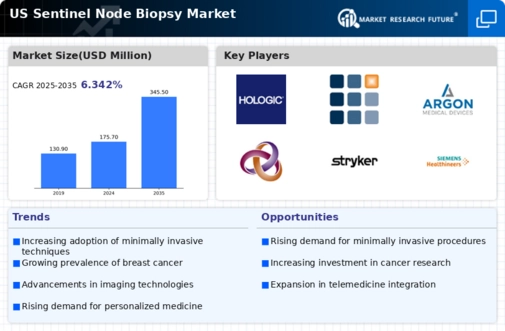Rising Incidence of Cancer
The increasing incidence of cancer in the US is a primary driver for the sentinel node-biopsy market. As cancer rates rise, particularly in breast and melanoma cases, the demand for effective diagnostic procedures escalates. According to the American Cancer Society, an estimated 1.9 million new cancer cases were diagnosed in 2021, with breast cancer being the most common among women. This trend suggests a growing need for sentinel node-biopsy procedures, which are crucial for staging and treatment planning. The sentinel node-biopsy market is likely to benefit from this rising incidence, as healthcare providers seek to implement less invasive techniques that improve patient outcomes while reducing recovery times.
Technological Innovations in Imaging
Technological advancements in imaging techniques are significantly influencing the sentinel node-biopsy market. Innovations such as enhanced ultrasound, MRI, and nuclear medicine imaging are improving the accuracy of sentinel node identification. These advancements allow for more precise localization of sentinel nodes, which is essential for effective biopsies. The integration of these technologies into clinical practice is expected to increase the adoption of sentinel node-biopsy procedures. As imaging technology continues to evolve, the sentinel node-biopsy market may experience growth driven by the demand for improved diagnostic accuracy and patient safety.
Increased Funding for Cancer Research
Increased funding for cancer research in the US is a notable driver for the sentinel node-biopsy market. Government and private sector investments are directed towards developing innovative diagnostic and treatment methods. The National Cancer Institute's budget for cancer research has seen substantial increases, which supports advancements in surgical techniques, including sentinel node-biopsy. This influx of funding is likely to enhance the capabilities of healthcare providers and improve patient access to cutting-edge procedures. Consequently, the sentinel node-biopsy market stands to gain from the ongoing research and development efforts aimed at improving cancer care.
Enhanced Training and Education for Surgeons
Enhanced training and education programs for surgeons are crucial for the growth of the sentinel node-biopsy market. As surgical techniques evolve, ongoing education ensures that healthcare professionals are equipped with the latest skills and knowledge. Institutions are increasingly offering specialized training in sentinel node identification and biopsy techniques, which is essential for improving procedural outcomes. This focus on education may lead to a higher adoption rate of sentinel node-biopsy procedures, as more surgeons become proficient in these techniques. The sentinel node-biopsy market is likely to benefit from this emphasis on training, as it fosters a skilled workforce capable of delivering high-quality patient care.
Growing Preference for Minimally Invasive Procedures
The growing preference for minimally invasive procedures among patients and healthcare providers is a significant driver for the sentinel node-biopsy market. Patients increasingly seek options that reduce recovery time and minimize surgical trauma. Sentinel node-biopsy, being less invasive than traditional lymph node dissections, aligns with this trend. As awareness of the benefits of minimally invasive techniques spreads, more healthcare facilities are likely to adopt sentinel node-biopsy as a standard practice. This shift in patient and provider preferences is expected to propel the sentinel node-biopsy market forward, as it offers a viable solution for effective cancer staging.



















Leave a Comment